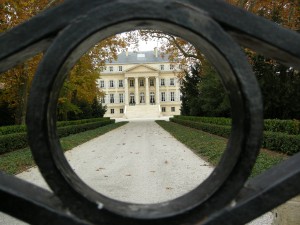 It was once an honour to be a second wine, and rightly so! In the meantime, it is almost a stigma to be only a second wine, the "two" just weighs on one's back. The wine scene has changed in recent years. People want "first wines" and if they can't afford them (or don't want them), there are alternatives: many excellent wines - not from the Bordelais, from other wine regions, but made "à la bordelais" - Bordeaux blends, as they are offered in all conceivable variations by many (also well-known and famous) wineries. I recently wrote about the Hess Vineyards Glen Carlou (Paarl, South Africa) flagship wine here in: "This special cuvée seems to me made, well made. It already starts with the five grape varieties permitted in Bordeaux - even Malbec is in it (16 percent) and probably ends with the ageing in French barriques, for 18 months" (see "Drunk" from 17 April). And it is a "first wine" - "second wines" actually only exist in Bordeaux - so without the two on the back - an excellent wine for just under 20 francs. It would now be unfair to compare the wine - vintage 2009 (a boy's spur) - with the "oldie" (vintage 1996) from Margaux. There are not only 13 years in between, but also other "wine philosophies", a changed wine world. It is also unfair to always look at the price. Back then, Pavillon Rouge cost about 50 CHF, today you have to pay over 100 "Schweizerfränkli" for it. South African Bordeaux, on the other hand, costs less than a fifth of that. These are worlds apart!
It was once an honour to be a second wine, and rightly so! In the meantime, it is almost a stigma to be only a second wine, the "two" just weighs on one's back. The wine scene has changed in recent years. People want "first wines" and if they can't afford them (or don't want them), there are alternatives: many excellent wines - not from the Bordelais, from other wine regions, but made "à la bordelais" - Bordeaux blends, as they are offered in all conceivable variations by many (also well-known and famous) wineries. I recently wrote about the Hess Vineyards Glen Carlou (Paarl, South Africa) flagship wine here in: "This special cuvée seems to me made, well made. It already starts with the five grape varieties permitted in Bordeaux - even Malbec is in it (16 percent) and probably ends with the ageing in French barriques, for 18 months" (see "Drunk" from 17 April). And it is a "first wine" - "second wines" actually only exist in Bordeaux - so without the two on the back - an excellent wine for just under 20 francs. It would now be unfair to compare the wine - vintage 2009 (a boy's spur) - with the "oldie" (vintage 1996) from Margaux. There are not only 13 years in between, but also other "wine philosophies", a changed wine world. It is also unfair to always look at the price. Back then, Pavillon Rouge cost about 50 CHF, today you have to pay over 100 "Schweizerfränkli" for it. South African Bordeaux, on the other hand, costs less than a fifth of that. These are worlds apart!
And yet it is precisely these "worlds" that are worth talking about. I found about fifty short test reports (and ratings between 87 and 93 points) for this Pavillon Rouge 1996 in an Internet community (Cellar Tracker). So people talk about it, they discuss it, it is a wine from the house of "Margaux" (Premier Cru) and therefore worth discussing, but also a rating that hardly goes above 92 points, because after all it is only the "second" wine.
The second wine, as almost all well-known châteaux in Bordeaux make it, is "the lower-priced version of the so-called grand vin. Pressing second wines (sometimes even third wines) is an annual practice, especially in the Bordelais. The cellar masters work with the same care as with the crus. A second wine is therefore by no means "rejects". What is it then, the so-called second wine? It is a wine made from grapes (mostly from younger vines) that (due to strict selection) do not make it into the so-called "first wine". In other words: the grapes of a château - even though they are excellent - are usually not simply mixed with the very best selection (this would result in a mediocre wine), but are pressed separately so that the "first wine" can become not mediocre, but top.
And so the second wine becomes "an affordable introduction to the Cru Classé for beginners". Whether wines at 50 to 150 CHF have an "affordable" dimension remains to be seen. At least with the second wine (there are also third wines) you can talk about the "greats" without having to pay several hundred francs for a bottle.
I haven't even said what the wine was like. For me, it is a beautiful, elegant, silky wine, not ostentatious, but full of excellent aromas: herbs, native and exotic, forest earth, notes of flowers and truffles and still with restrained fruit. Isn't this something that gives pleasure and isn't this much more important than an A or even a B on the back?